JoJo's Bizarre Adventure
Introduction
JoJo’s Bizarre Adventure is a manga penned by one Hirohiko Araki. It began publication in 1987, and is still a going concern today.
I think I first heard of JoJo’s Bizarre Adventure in 2019, possibly in relation to Saiki K, which contains several references to JoJo. The “Bizarre Adventure” part sounded promising, so I googled it. The image results revealed vivid, bewildering depictions of innumerable characters in contorted poses, and wearing outlandish costumes in jarring colours. I had no idea what I was looking at, but I definitely liked it. I read up on Wikipedia for a plot synopsis, and learned that the manga was a multigenerational saga featuring heroes with strange names in stranger scenarios. It still seemed mysterious, but again I was intrigued. But for the next couple of years all I did was periodically image search the managa and admire the artwork.
So I didn’t seek out JoJo’s Bizarre Adventure, but eventually JoJo came to me, when the first season of the anime adaptation turned up on Netflix in early 2021. I dived in straight away, and it turned out that JoJo world is every bit as weird and fantastical as I’d hoped. To tell you the truth, I’ve become a bit obsessed with it. I figured I might be able to extirpate my obsession by writing a brief survey of the JoJo phenomenon. So here goes.
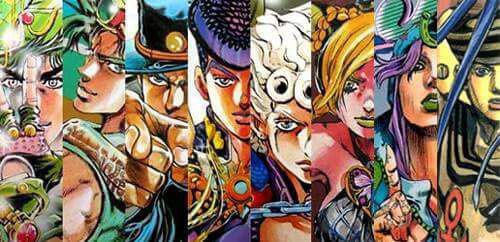
The essence of JoJo
The saga is split into nine parts, with each part being a mostly self-contained story with a new protagonist. The titular JoJo is actually 9 different members of the Joestar dynasty, though strictly only two are called “JoJo” (the rest have “Jo” at the start of their given names). The broad premise of each part is that a JoJo and his or her allies are pitted against a suitably nefarious antagonist and their cronies.
As I understand it (from a cursory glance at Wikipedia), JoJo’s Bizarre Adventure follows the convention of a “tournament” manga. As this would imply, the bulk of the plot is taken up with frequent showdowns. Combat rituals include:
- combatants conducting lengthy monologues (internal or external) about their strateg
- frequent trash talking
- numerous reversals of fortune as each antagonist trots out their special moves.
If the bare-bones of the tournament genre doesn’t sound that interesting - and note that millions of Western wrestling fans will completely disagree with you - JoJo’s Bizarre Adventure’s point of difference is to make the confrontations frequently convoluted, weird, and grotesque. So, you know, sign me up!
The parts
In this section I’m going to outline synopses of the existing eight parts to give a flavour of the story.
There’s one thing I should acknowledge up front: it will quickly become apparent that Araki routinely gives characters the names of Western pop or rock groups, or the names of their songs. How a particular name lands with you will depend on your appetite for whimsy, or your musical taste. See what you think; I’ll come back to this subject later.
Part 1 - Phantom Blood (1987)

The saga kicks off with the adventures of Jonathan Joestar (nicknamed JoJo), an upper crust kid in 1880s England. He’s in conflict with his adoptive brother Dio Brando, a ne’er do well orphan with designs on the Joestar fortune. All is relatively mundane at first (give or take a barbecued dog) until Jonathan discovers that Dio is trying to poison Jonathan’s dad. In desperation, Dio dons the family Aztec ritual stone mask, and is handily transformed into a vampire. Custody is duly evaded.
Though built like a brick shithouse, Jonathan can’t take on vampire Dio without a powerup. Lucky then that upon realising this, Jonathan immediately meets Will A. Zeppeli, a flamboyant Italian practitioner of the art of “ripple” (“hamon” in Japanese), the energy of the sun that a practitioner gains - somehow - through breathing a certain way. With the ripple mastered, Jonathan can now punch vampires in a way that obliterates them.
With the aid of Zeppelli and cockney chum Robert E.O. Speedwagon (geddit??), JoJo confronts Dio and his vampire horde. Who will be victorious?
Does all that sound a bit corny? Well, it’s absolutely my kind of cobblers. Nothing is done by halves: Dio is an utterly scurrilous villain, while Jonathan embodies chivalric English gentlemanliness to the point of tedium. If our protagonist and antagonist are unremarkably good vs evil, there are at least plenty of lurid incidental details to keep the reader or viewer engaged. My own favourite is when Jonathan and his chums are ambushed by a zombie Jack the Ripper erupting out of the body of a horse. Meanwhile, in classic manga style, combatants announce their special moves as they perform them; Jonathan’s being the rousing (if dish-washing liquid reminiscent) “SUNLIGHT YELLOW OVERDRIVE!”
Phantom Blood is a somewhat flawed prototype for the larger JoJo saga: its charm being strictly of the “so weird it’s good” variety. Many readers skip the part altogether to get to the better stuff. I think doing this would be a shame; for all its faults Phantom Blood is always engaging, and I’d recommend it to anyone who loves campy heroic (and gory) action.
This is spoilers, but it’s sort of necessary to explain the whole saga: after less than a year of writing Phantom Blood, Araki decided to kill Jonathan off, his prime motivation being that Jonathan was “a bit boring”. Jonathan’s send off was typically understated (I kid of course, it’s fairly insane).
Having a protagonist snuff it was unheard of in late 80’s shonen manga, so Araki was taking quite a gamble with his readers. Happily, though, the experiment paid off, and the stage was set for decades of periodic JoJo reinvention.
Part 2 - Battle Tendency (1987 - 1989)

JoJo’s Bizarre Adventure’s second chapter is the aptly-named Battle Tendency, a globe-trotting Indiana Jonesy adventure set in the late 1930s. The new JoJo is Jonathan’s 19 year old grandson Joseph, a wise-cracking goof prone to running away when the chips are down (a practice he refers to as his “ultimate technique”). As should be immediately clear, Joseph is nothing like Jonathan.
Extending the stone mask backstory, Joseph is pitted against Aztec superbeings Kars, Whammu, and Eisidesi (Cars, Wham, AC/DC, naturally), collectively known as the Pillar Men. Aiding Joseph in this conflict are his frenemy Caesar Zeppeli (grandson of Will. A), the enigmatic Hamon instructor Lisa Lisa, and Rudol[sic] von Stroheim, a… well, there’s no pussyfooting around it: he’s a Nazi. (I concede this detail is a bit “problematic”, but the tone is so absurd - esp when von Stroheim becomes a cyborg with a cannon protruding out of his chest - that it seems churlish to take it seriously.)
The plot involves the Pillar Men being awakened from thousands of years of slumber by those pesky Nazis. Joseph hastily trains up in Hamon master (mostly off-screen), and then works to protect the Stone of Aja (a glowing ruby manga macguffin) and generally thwart the Pillar Men’s plan to become “ultimate lifeforms”. The subdued climax of the story involves Joseph and Kars battling it out on a chunk of rock htat’s being ejected into space by an erupting volcano.
Battle Tendency is a rollicking adventure that marks a significant narrative improvement on Phantom Blood’s reliance on schlock and awe. It’s not a perfect story by any means, but it’s good fun.
Part 3 - Stardust Crusaders (1989 - 1992)
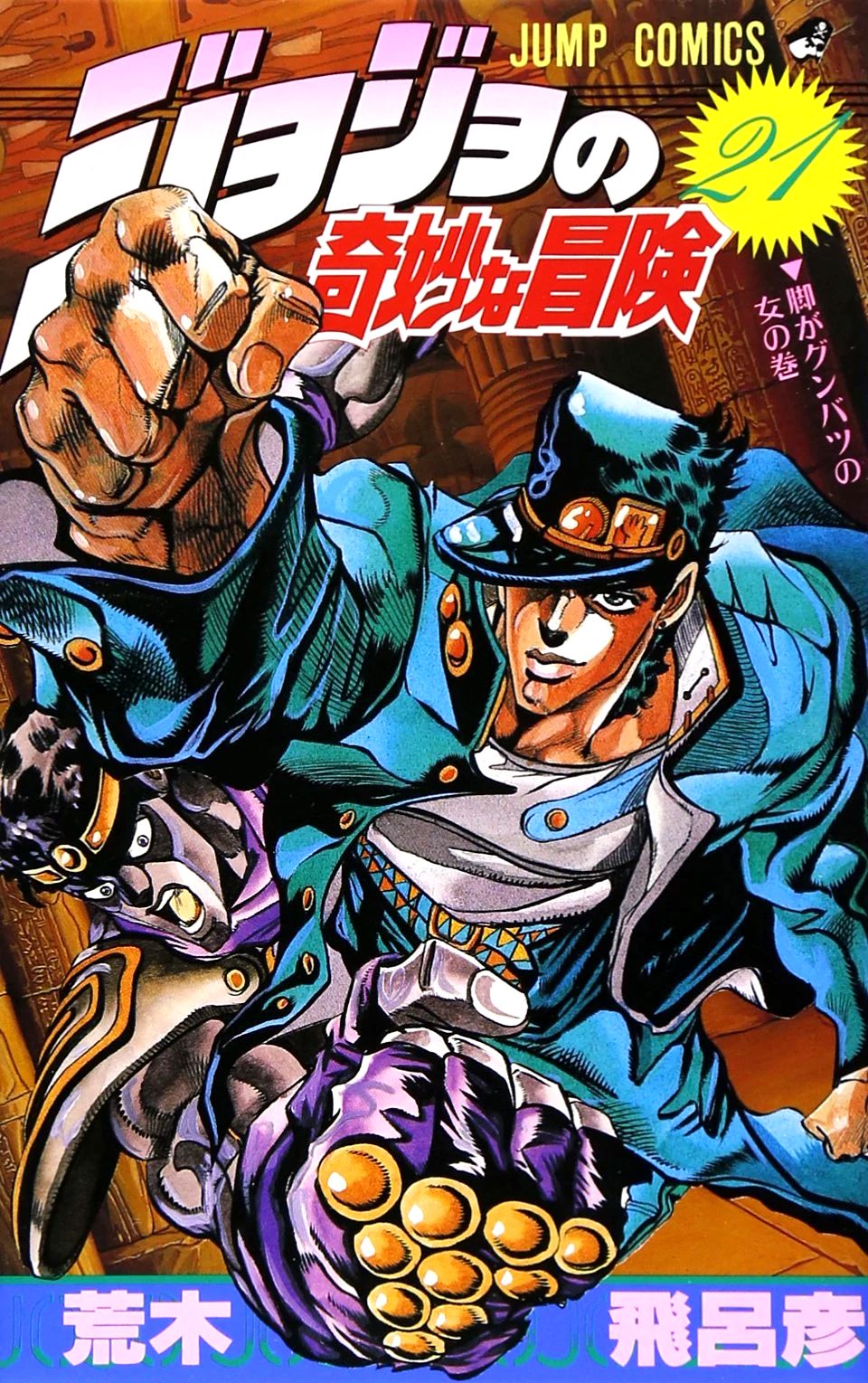
The third JoJo outing featured some significant tweaks to the format. Bored with taking his protagonists through the plot mechanics of learning the Hamon technique, Araki invented the concept of “stands”, Hamon spirits controlled by a human user. Each stand has a unique set of reality warping qualities that is used as a proxy warrior when foes battle. And, to satisfy Araki’s narrative requirements, stands are an emergent property of their user’s personality, and therefore don’t require training. Apparently…
To get a better idea of how stands work you could watch a JoJo’s Bizarre Adventure anime battle clip on YouTube, but the link I’ll toss in here is some game play from the entirely understated 1998 JJBA arcade game (made by the creators of Street Fighter!).
Stardust Crusaders also leaves behind the stone mask and Aztec vampire “mythos”. There is one nod to the earlier parts: the return of Dio!
The story: it is the late 1980s. Dio has returned after spending a century in a coffin at the bottom of the Atlantic. Worse still, he’s managed to cobble his severed head onto the body of Jonathan Joestar. Additionally, his name apparently gets stuck in capslock, and he’s henceforth known as DIO. With the help of witch Enya the Hag, Dio acquires a stand. And because Jonathan’s body is involved, Jonathan’s descendants (Joseph Joestar, Joseph’s daughter Holly, and her half-Japanase son Jotaro Kujo) also acquire stands.
With me so far? Ok. An ageing but admirably buff Joseph Joestar visits Jotaro and Holly in Japan and helps Jotaro to control his new stand’s destructive and kleptomaniac tendencies. (Said stand is named STAR PLATINUM. I’ll henceforth refer to stands in caps as well, because stand users tend to portentously announce their names when deploying them, and ALL CAPS conveys the majesty of this better). Holly falls ill because her stand is too powerful for her delicate feminine nature (apparently), and in order to save her Joseph and Jotaro must kill DIO within 50 days!
With this ticking clock in place, the Joestars (aided by comrades Avdol, Kakyoin, Polnareff, Iggy) journey to DIO’s lair in Egypt. Along the way they are ambushed by a what feels like an unending number of stand users allied to DIO. Eventually they reach Cairo and the final battle pits DIO and Jotaro stando a stando.
Stardust Crusaders was the story that made JoJo’s Bizarre Adventure famous in Japan. Because of this, Jotaro is generally seen as the definitive JoJo. Theoretically dressed like a delinquent Japanese school boy (though looking more like a 30 year old K-pop singer), Jotaro certainly looks the part. Araki based Jotaro’s demeanour on Clint Eastwood’s Dirty Harry, so he’s basically a stoic, callous, antihero grump who glowers at his surroundings with the dead eyes of a bird of prey. But all this is window-dressing; what makes Jotaro truly a rebel is that he’s frequently rude to his mum. (This must be truly thrilling to adolescent Japanese readers…)
I think Jotaro’s character design is perhaps Araki’s best, and he deserves his iconic status. That said, his surly nature makes him unsuitable for handling the story’s comic moments - of which there are many - so much of Stardust Crusaders’ narrative focus is given to the comical Polnareff, and the reliably entertaining Joseph Joestar. This decoupling of the narrative from the protagonist would become more prevalent in subsequent parts.
Despite the iconic status of Jotaro and his gang, much of Stardust Crusaders’ structure is episodic and repetitive, and while there are plenty of memorable moments, the narrative between Japan and Egypt (ie 80% of the story) is a bit monotonous.
Part 4 - Diamond is Unbreakable (1992 - 1995)
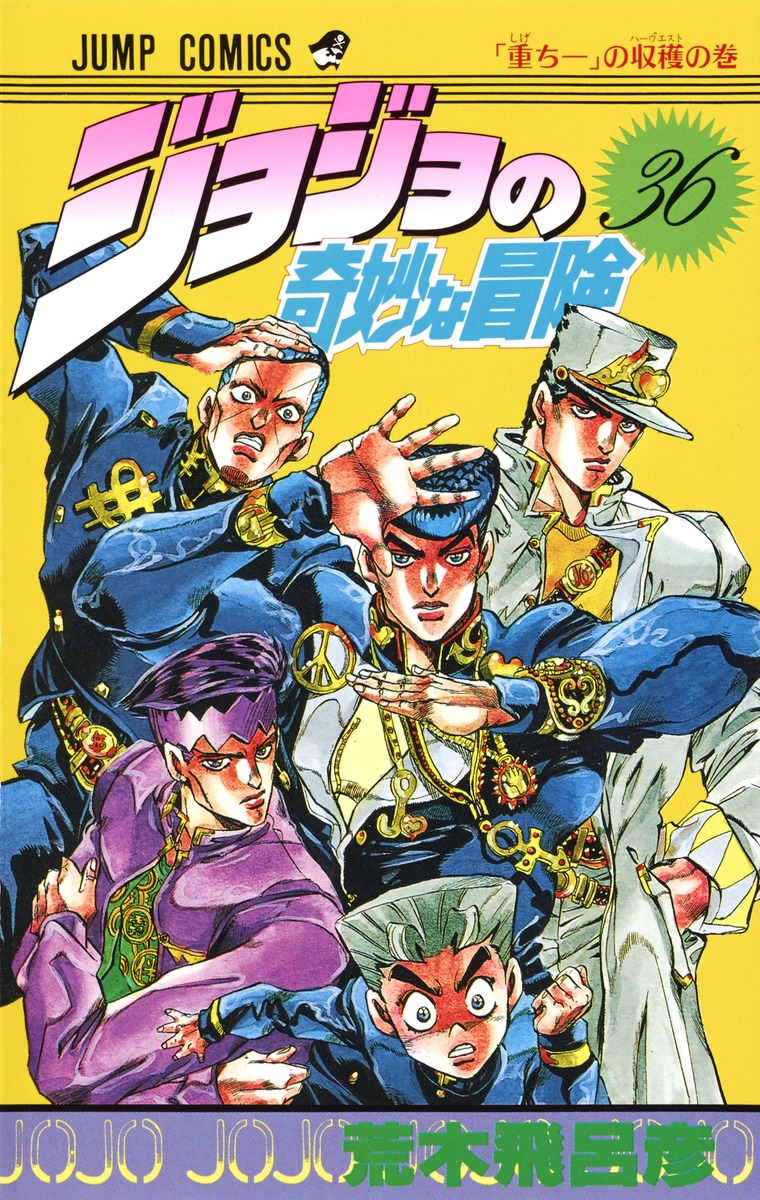
In a marked departure from the shifting settings of the previous three parts, Diamond is Unbreakable’s story is confined to a single location: the fictional Japanese seaside town of Morioh. Additionally, Araki made an upgrade to the “lore”: in Stardust Crusaders, the origin of stand abilities was left unexplained, but in Diamond is Unbreakable standness is conveyed upon a person when they are pierced by a magical arrow (the ultimate origin of which is unexplained).
The story: it’s the far off future of 1999, and our new JoJo is schoolboy Josuke Hishigata, the illegitimate son of Joseph Joestar. Joseph himself is now elderly and frail, so Jotaro is now saddled with the expository pronouncements, and he isn’t happy about it. As a Joestar Josuke has a DIO-inherited stand called CRAZY DIAMOND, which has the somewhat paradoxical qualities of being able to both inflict immense violence and to heal as well. (From a narrative perspective, CRAZY DIAMOND allows Araki’s heroes to suffer terrible injuries and still survive. Consequently there are lots of wince-inducing moments in the story.)
The initial arc of Diamond is Unbreakable sees Jotaro coming to town to protect Josuke from a stand-wielding killer. It transpires that an additional, unknown agent is going about Morioh spiking residents with a stand arrow to create a diverse array of new antagonists and allies. Once Josuke and his stand-wielding schoolfriends (Jotaro remains present but on the sidelines) have dealt with this initial swarm of villains, the central big bad of the story appears. Kira Yoshikage is a seemingly mild-mannered (if strikingly Bowie-esque) fellow who has been unobtrusively killing women in Morioh for years (with help from his sinister stand, KILLER QUEEN). Learning of Kira’s existence, Josuke and his gang set about tracking him down. Kira is careful and cunning, but how long can he stay ahead of his pursuers, and what will he do when he is finally unmasked?
While the preceding synopsis is greatly simplified, it demonstrates how Araki’s storytelling has become more sophisticated since Phantom Blood. But the true joy of Diamond is Unbreakable is the wealth of characters and detail Araki uses to populate Morioh. (Indeed, Araki fell in love with Morioh so much that he returned there in part 8.)
If Jotaro was at times slightly sidelined as the main character in Stardust Crusaders, Josuke is even more so in Diamond is Unbreakable. But this time it’s less from necessity, and more because Araki wants to explore the lives of the denizens of Morioh. In particular, much coverage is given to the travails of Josuke’s diminuitive friend Koichi, and, later in the story, the mangaka Rohan Kishibe. Diamond is Unbreakable is really an ensemble piece.
Despite this narrative de-emphasis, Josuke is still a fleshed out character (moreso than the one-note Jotaro); in fact in some ways Josuke is the most grounded of all the JoJos. While he is imbued with typical Joestar heroism, he’s also very much a high school kid: he comes up with (very dubious) schemes for making money, and makes some goofy choices. His relationship with his estranged father Joseph is also nuanced. Eventually they’re sort of reconciled, but there’s never a sense of happily ever after. In fact the biggest satisfaction Josuke gets from the relationship is when he manages to steal Joseph’s wallet.
If Josuke is the most down-to-Earth JoJo, Kira is the most relatable villain. While the portrayal is hardly sympathetic, we do have opportunity to see inside Kira’s and understand him a bit better. Much time is given to Kira’s nightmarish experiences trying to evade detection and resume his quiet life.
It’s also worth mentioning that despite its relatively down-to-earth setting, Diamond is Unbreakable still manages to serve up the sort of sublime nonsense for which JoJo’s Bizarre Adventure is famed. There’s the chap who is trapped inside his stand, SUPER FLY, which manifests in the physical form of an electricity pylon. There’s the appearance of an apparent extraterrestrial, Mikitaka Hazekura, whose shapeshifting abilities are co-opted by Josuke to best Rohan at gambling. Most brain-cracking of all is when the ghost of Kira’s father, Yoshihiro Kira, entered the story. You see Yoshihiro gets trapped by Jotaro in a polaroid photo taken by Yoshihiro’s stand, a supernatural camera called ATOM HEART FATHER. Yoshishiro manages to grab the stand arrow, and escapes when his photographic domicile gets blown away on the wind. He then goes on an arrow spiking spree in order to create new stand users that he persuades to fight Josuke and co. I cite this as an example of how the JoJo crazy can get very convoluted.
All up, Diamond is Unbreakable is the best JoJo’s Bizarre Adventure story the anime has covered. In terms of quality, and with its small town vibe and psychedelic whimsy, Diamond is Unbreakable feels a bit like Araki’s equivalent of Sgt. Pepper’s Lonely Hearts Club Band (a comparison I think he might appreciate).
Part 5 - Golden Wind 1995 - 1999

For the next JoJo adventure we travel from Morioh in 1999 to Italy in 2001. But first, a detour back to the mid 80s! While in Cairo waiting for the Stardust Crusaders to show up, DIO impregnated a Japanese woman, and the resulting issue was the suspiciously blond Giorno Giovanni. Now, you’ll recall that DIO ended up being a vampire’s head on Jonathan Joestar’s body, so Giorno is actually Jonathan’s son, and therefore a JoJo (or in this case, GioGio!). Even so, however, Giorno has DIOish blond hair, and shares DIO’s battle cry of “Muda muda muda!” (“useless useless useless!”). So is Giorno a goodie or a baddie?
On to the story, set in the year 2001. Jotaro learns of Giorno’s existence, and dispatches poor little Koichi to Naples to ascertain if Giorno is good or evil. After getting off on the wrong foot with Giorno, Koichi eventually determines that Giorno is benign, and promptly exits the story to allow Giorno to take centre stage.
As a Joestar, Giorno is automatically entitled to a stand, and his is called GOLD EXPERIENCE. It comes with the power to transmute objects into living matter (small animals, plants, etc), making him, like Josuke, both a dealer of damage and a medic.
At the start of the story Giorno is a petty Neapolitan thief, but he, Giorno, has a dream: to break up the drug-dealing mafia gang known as “Passione”, by taking out its enigmatic Boss.
Giorno has a run in with junior mafioso Bruno Bucciarati (stand: STICKY FINGERS; haircut: bowl) and their battle goes so well that not only does Giorno win, but he manages to co-opt Bucchiarati to his cause. Giorno joins Bucciarati’s mafia unit, La Squadra. Soon after the gang get assigned to protect the Boss’s daughter Trish (eventual stand: SPICE GIRL). Bucciaratti delivers Trish to the Boss, but trouble breaks out, and the gang is forced to go on the run with all of Passione hunting them. The final confrontation occurs in the Colisseum (previously visited in part 2). Passione’s Boss is revealed to be the dastardly Diavolo (Italian for the devil, geddit!), whose fearsome stand KING CRIMSON can undo the causation of events affecting him. Who will prevail??
Golden Wind is Araki’s homage to both Italy and mafia dramas. 15-year old Giorno is modelled on Michelangelo’s David (if David wore a braided ponytail and sported three pastry rolls on his forehead). The story can be summed up as Goodfellas with stands, which at face value is a winning premise.
Sadly Golden Wind turns out to be the weakest of the JoJo parts I’ve consumed so far. There are two critical flaws. The first is that Giorno’s character is very flat. He’s not got Joseph’s chutzpah, Jotaro’s flintiness, or Josuke’s charm. Even Jonathan Joestar has more personality. In fact Giorno is overshadowed in his own story by La Squadra’s other members, especially Bucciarati. Even standard-issue, damsel-in-distress Trish gets more development.
The second problem is that the climax of Golden Wind is muddled and confusing. It’s ok for a reader to be baffled by a JoJo ending, but you should be loving the weirdness, not frowning because you have no idea what’s going on.
Golden Wind’s narrative may have some flaws, but the situation is not all bad. The character designs are some of Araki’s most out-there creations, there’s several compelling stand fights are, and Diavolo is perhaps Araki’s creepiest villain (creeper even than serial killer Kira). Nevertheless it’s notable that while each part in the series up to this one had improved on the last, Golden Wind marks the first dip in quality.
To sum up, I would say that if Diamond is Unbreakable was Araki’s Sgt. Pepper, Golden Wind is very much his White Album. Even so I’m obliged to point out that Golden Wind is very popular with Western fans of JoJo’s Bizarre Adventure, so my opinion may be very much in the minority.
Part 6 - Stone Ocean (1999 - 2003)
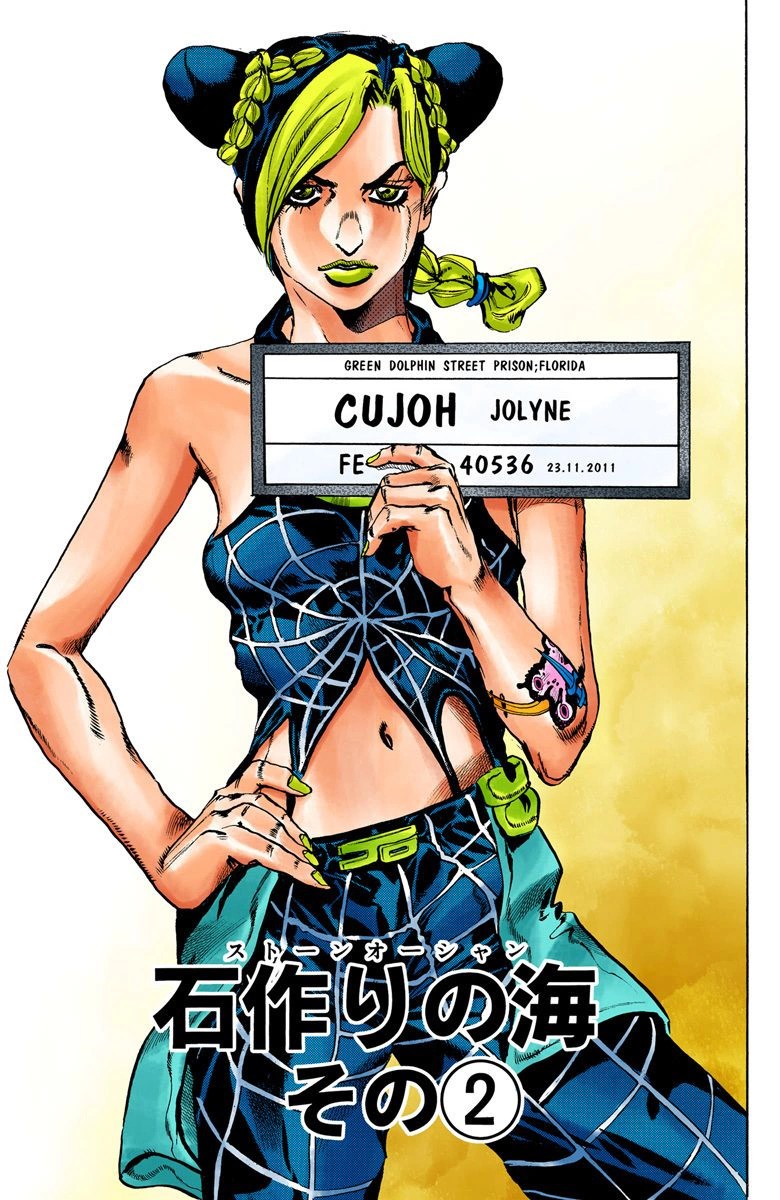
Until part 6, JoJo’s Bizarre Adventure’s female characters were few in number and seldom well-realised. Part 1’s Erina was girlfriend-by-numbers, and though part 2’s Lisa Lisa was cast as a badass femme fatale, she didn’t rise much beyond noir cliche, and she endured a few demeaning moments. As for Stardust Crusaders, it was largely female free, aside from Jotaro’s feeble mother Holly and the wicked crone Enyaba. Diamond is Unbreakable did have more female characters: the frighteningly possessive Yukako Yamagishi and ghost girl Reimi Sugimoto being the most prominent. Again, though, their roles were more peripheral to the frankly sausage-heavy core cast.
It’s true that shonen comics tend to be very masculine in their focus, but Araki’s career has been about transcending manga cliches in interesting ways, and he was clearly capable of better. With Stone Ocean he finally delivered, giving us our first lady JoJo, Jolyne Kujo. Araki further intensified the female focus by setting the story primarily in the women’s wing of Green Dolphin Street prison, providing Jolyne with some female sidekicks. I should be careful here: strictly speaking one sidekick is a colony of zooplankton (pronouns unknown), but they(?) “pass” as female. (I’m down with this identity crap, mother fuckers…)
The premise: it’s 2011 and Jolyne Kujo is framed for a crime she didn’t commit! When sentenced to many years in prison, her estranged daddy Jotaro helps out as only he can: by giving her part of a stand arrow so that she may accidentally pierce herself with it and thereby obtain a stand. Once in possession of her stand, STONE FREE, Jolyne can protect herself in prison. After Jotaro is left grievously injured in a prison visit gone very wrong, Jolyne is faced with needing to save her father, unmask the secret villain behind the assassination attempt, and escape from Green Dolphin Street Prison.
This initial premise promises none of the mucking around that marred Golden Wind. However the narrative quickly descends into a bunch of pointless stand battles to kind of pad things out. The climax, when it comes, however is spectacular and of truly cosmic import, concluding the wider Joestar saga. Is it good? Well, Araki had a vision, and by golly he sees it through. I respect it, but in my hard of hearts it feels anticlimactic to me.
Part 7 - Steel Ball Run (2005 - 2011)
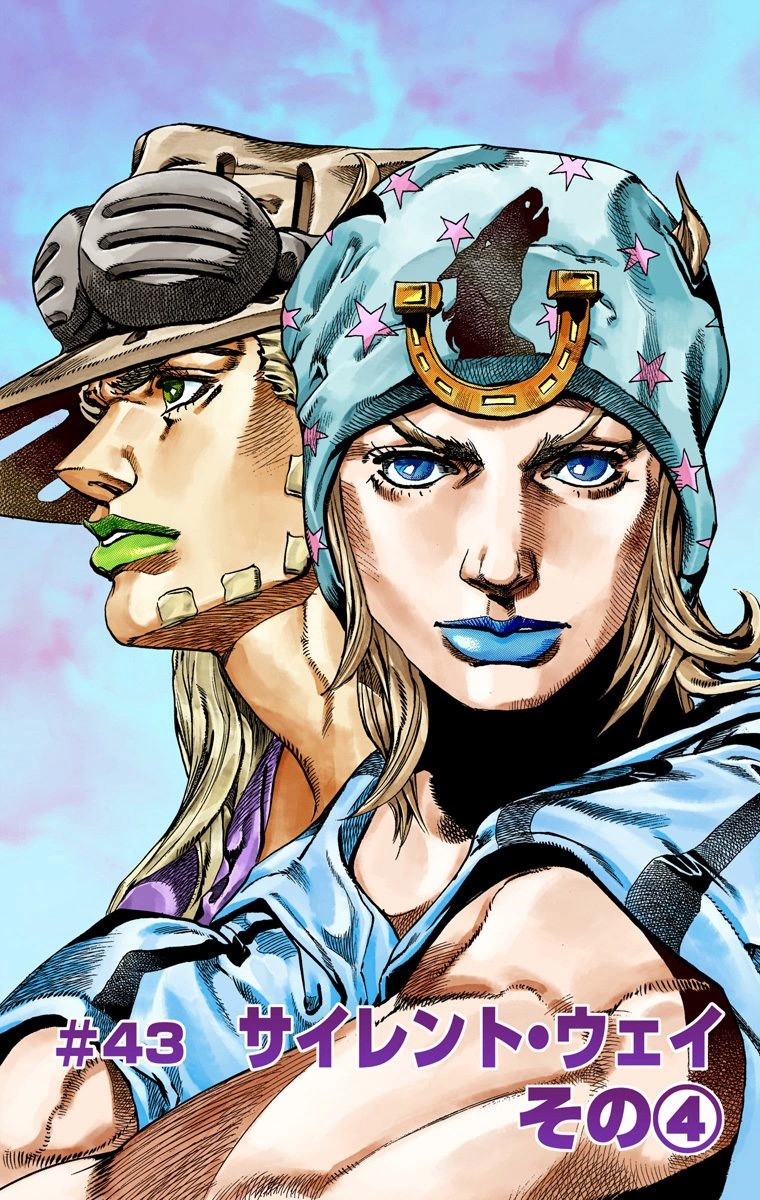
After Stone Ocean Araki reset the narrative timeline, and Parts 7 through 9 occur in a different universe. Steel Ball Run is a retelling of Jonathan Joestar’s story, except with the premise scrambled.
We’re back in the late 19th century (1890 now) and Johnny Joestar is a paraplegic jockey understandably down on his luck. He meets Gyro Zeppeli (this part’s Will. A. Zeppeli), who possesses mysterious spin power over his “steel balls” (literally; this isn’t a euphemism…) which Johnny believes can cure his paralysis. Johnny tags along with Gyro in a horse race across the USA called the Steel Ball Run (which is presumably a reference to the Burt Reynolds “classic” The Cannonball Run).
At time of writing there is no anime adaptation, but I found the premise so intriguing I “obtained” the manga and consumed it. It’s pretty good, though a little overlong, packing in just a few too many inscrutable stand confrontations. Visually it’s very impressive, however, and I find the flair of the designs for Johnny and Gyro in particular to be among the best Araki has produced. Johnny sports a jockey silks and a horseshoe-emblazoned cap, looking somewhere between a gypsy fortune teller and a 1930s Hollywood starlet. Gyro, the caped cowboy with coolishly impractical goggles and hat is, well, pretty awesome!
It’s worth pausing a moment to ponder Araki’s decision to reboot the saga. Normally when this happens in a comic (see endless Batman/Superman/Spiderman reboots) it’s a sign the story running out of creative steam. Reboots are also dangerous generally because they dilute the original story by making it a bit whatever you want it to be. Seldom a good look.
On the other hand, if you’ve told as much story as you feel you can with the Joestars, and you want to write a 19th Century Western JoJo story, well, why not reset everything in order do that?
A new continuity would be the most plausible way to achieve this. Additionally it appears Johnny is only a very loose analogue of Jonathan, so it’s not so much an alternative past as a completely new story. In short, I think the SBR reboot is a reasonable way to keep telling more JoJo stories.
Part 8 - JoJolion (2011 - 2021)
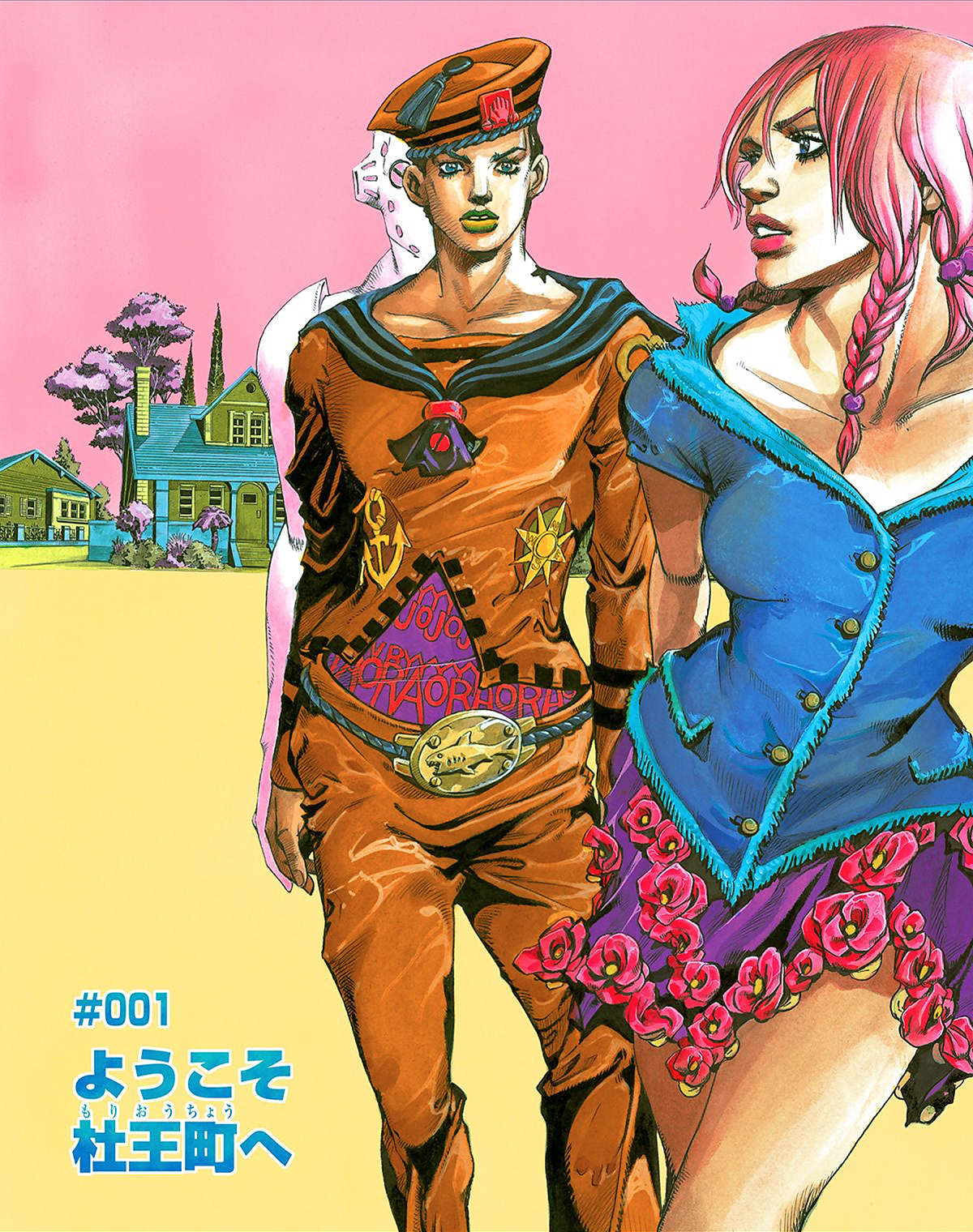
JoJolion is the SBR universe equivalent of Diamond is Unbreakable. I know even less about JoJolion than SBR. The protagonist, who is also called Josuke Higishigata as in Diamond is Unbreakable, wears a sailor suit and trainers. Sadly, his stand is not called New York, New York…
Once again the look is amazing. And that’s all I can say of the story until it gets an anime adaptation in approximately four years.
SBR posed the question “why reboot?”; JoJolion makes me wonder “why return to Morioh?”, especially if the first time round is the high point of the manga. It would be justified if the story Araki wanted to tell is a good one, but if not, JoJolion is just a creative retread.
Part 9 - JoJolands
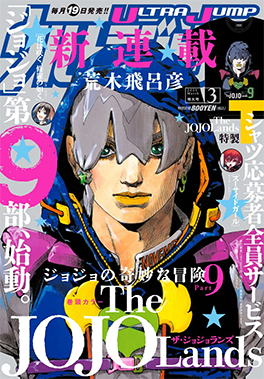
More than a year after the end of JoJolion, JoJolands debuted. As my first experience of a new JoJo part kicking off, my anticipation was great. What would the new JoJo be like? What would the setting be? What sort of humorous shenanigans go down?
Well, three chapters in, we know that JoJolands is set on Hawaii, and features Jodio Joestar, a drug-dealing high schooler, and his trans sister Dragona. They’re involved in a heist to steal a diamond from none other than Part 4’s Kishibe Rohan (though presumably the SBR continuity’s equivalent of that character).
The premise is certainly intriguing, and the choice to make Jodio a petty criminal is a departure from the standard JoJo formula (I guess technically Giorno was a gangster, but in practice a pretty righteous one). This presents great potential for character development, but I have to say so far I’m not finding the story very interesting. Three chapters in the characters are pretty charmless and story humourless. I’m trying to think back to any other JoJo part with an unengaging beginning. Phantom Blood was pretty ho-hum until Jonathan beat up Dio the first time, and the beginning of part 5 was a bit underwhelming, too. Well, see how we go, I guess.
Thus Spoke Kishibe Rohan

Araki’s first JoJo spinoff was Thus Spoke Kishibe Rohan, an anthology horror series involving the mangaka character (and author insert) from Diamond is Unbreakable. A short series animating four of those stories is available on Netflix. What could be a largely disposable folly is redeemed by Araki’s highly developed sense of the macabre. While all of JoJo feels very Japanese regardless of the setting, Thus Spoke Kishibe Rohan’s ghost stories feel instensely like Japanese ghost stories.
The show is well worth the brief amount of time to watch. Because each episode is stand-alone, a useful side-effect is that they provide the JoJo-uninitiated with an easy entry point to the Arakai’s style, without having to endure the silliness of the first episode of Phantom Blood or the backstory-heavy commencements of later parts. That’s my recommended starting point for aspiring JoJo’s Bizarre Adventure consumers, anyway.
The future
The meme that Araki is immortal notwithstanding, the great man is in his 60s now, and given JoJolion took 10 years to complete, part 9 may well be the last JoJo’s Bizarre Adventure part before he retires. Alterntatively, in recent years Araki has handed out the keys to other mangaka to produce spinoff JoJo stories, and this suggests the possibility of a post-Araki life for JJBA. Would that life be interesting without Araki’s genius? I would say almost certainly not, but a mangaka of similar talent could make a good go of it.
Discussion
Now you have a bit of a handle on the story, I’m going to make some commentary on the JoJo phenomenon. It’s going to be a bit scattershot, but will hopefully provide the reader with some entertainment.
The anime
The anime adaptation by David Productions has been pretty good so far. Seasons 1-3 (covering parts 1 - 4) had a sense of assuredness and confidence, and a commitment to not only depict but also celebrate JoJo’s Bizarre Adventure. As will be apparent with the lengthy music discussion below, a lot of effort was put into the score.
At times the faithfulness of the adaptation is almost a detriment to the animation. The pacing of season 1, featuring two parts in 26 episodes, is brisk and lively compared to the interminable slog of the 48 episodes of season 2 (the entirety of Stardust Crusaders). While seasons 3 and 4 (Diamond is Unbreakable and Golden Wind) were pared back to 39 episodes apiece, these seasons too are bit mushier (in my mind at least) than season 1.
It’s hard to say exactly why, but seasons 4 and 5 (parts 5 and 6) don’t have quite the same shine as earlier instalments. Proceedings don’t feel as festive. I’m not sure if it’s a drop in quality, budget, or a change in tone to the stories, but things seem less lighthearted and fun, and perhaps more of a chore. (Interestingly, the recent animation of the JoJo’s Bizarre Adventure spinoff Thus Spoke Kishibe Rohan does have a more tongue-in-cheeck feel.) Ultimately, I’m not sure I can disentangle this impression from the fact that I’ve found the stories of parts 5 and 6 less enjoyable than earlier chapters.
Araki’s visual style
Araki is very much into fashion and art, in particular Italian Renaissance art (which may explain the almost sculptural visual sensibility of JoJo’s Bizarre Adventure - or to put it more plainly, all that JoJo posing).
The art style of JoJo’s Bizarre Adventure has consistently evolved since 1987. Phantom Blood and Battle Tendency weren’t too visually oeutre, at least compared to later works, though Araki provided highly baroque covers for the JJBA manga volumes of the time, which hinted at a desire to bust out some crazy. The character designs in Stardust Crusaders were much more distinctive, and a further quantum shift happened with Diamond is Unbreakable. The musclebound physiques of the early JoJo parts slimmed down considerably, and the facial designs became more stylised.
Araki went to an extreme of outlandishness with Golden Wind, before reining it in somewhat with Stone Ocean. Steel Ball Run saw a move to a softer, more austere style, especially with characters’ faces. In fact you could argue that since 2005 every character in JoJo’s Bizarre Adventure has had the same face: blank eyes, lips pouting, expressionless and seemingly unknowable. Goodies and baddies alike could appear on a Vogue cover. These stares have a feel of otherworldly contemplation, if you want to state it charitably; but there’s also a dehumanising quality, like looking at a collection of automatons.
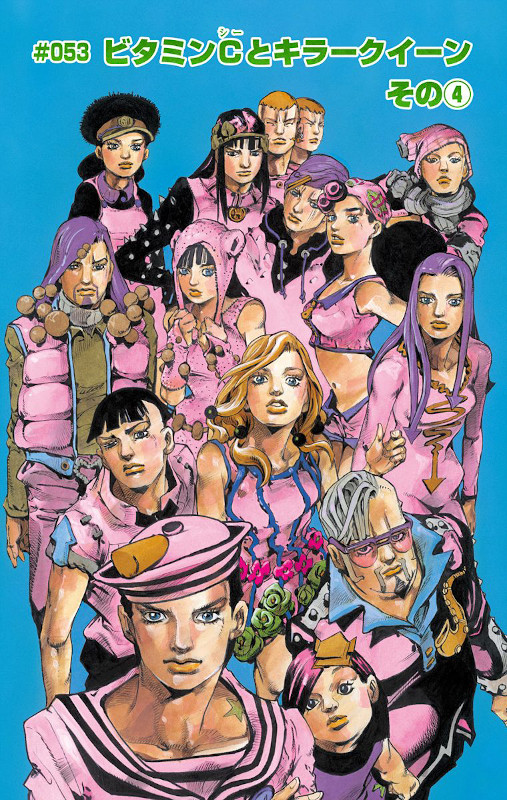
And yet the effect of the art remains beguiling and intriguing, so I’m a bit torn. It would be interesting to see where (if it all) Araki’s style might evolve next.
Music
I’m going to ramble about a series of music-related topics with which JoJo’s Bizarre Adventure intersects.
Musical character names
As mentioned earlier, Araki habitually names characters (or their stands) after Western rock groups, and more often than not the effect of this - for me at least - is both jarring and amusing. One early example: Jonathan Joestar and friends get confronted by a reanimated medieval knight named Bruford (“Bluford”, technically, see Localisation below). Now “Bruford” is an English name, but if you’re already aware of names like “Speedwagon” and “Dio”, you’ll conclude that it’s a reference to Bill Bruford, drummer of King Crimson.
Araki’s musical taste is apparently very eclectic, with JoJo’s Bizarre Adventure characters or stands named after musical acts as disparate as Mariah Carey, Steely Dan, Dire Straits, the Sex Pistols, and Smokey Robinson. Some names suggest impeccable taste, while others are kind of laughable: Stardust Crusaders’ penultimate antagonist is a formidable opponent underwhelmingly named Vanilla Ice. (Though the situation is somewhat redeemed by said antagonist’s stand being called CREAM.)
What is the meaning of all this?! On the one hand this naming convention feels arbitrary, like Araki just went through an encyclopaedia of rock and used names at random. I have no reason to believe that he actually did this, but the effect is largely the same.
Quibbles aside, Araki’s musical naming convention is at least kind of fun when he names stands after bands I like at least. And he does manage to make the Queen song Killer Queen sinister, which is quite an achievement. That said, I’m disappointed there’s no ABBA or BEEGEES. Perhaps something for part 9?
Localisation
The strangeness of Araki’s musical naming convention is taken to a higher power via the practice of “localisation”, where the English translation of a manga/anime name referring to real world entities are “subtly” renamed, in an effort to avoid copyright problems. The renaming can be as simple as using the Japanese transliteration of the non-Japanese name. For example, Wham becomes “Wammu”. But at other times, an alternative name is used. For example, Santana, a character in Battle Tendency, is renamed “San Viento” in the manga/anime. Jolyne’s stand STONE FREE is renamed Stone Ocean.
But sometimes the results of localisation changes are unintentionally funny. One that sticks in my head (because the change is almost antithetical to the original) is the stand named KRAFTWORK, which gets localised to “Arts and Crafts”. The most humorously awful localisation change, by quite some margin, is DIRTY DEEDS DONE DIRT CHEAP (a moniker given to a Steel Ball Run stand), which localisation mutates to “Filthy acts, at a reasonable price”.
The Anime soundtracks
Original music
The chief joy of the Phantom Blood arc of the anime’s first season is opening theme “Sono Chi no Sadame”, a rollicking piece of theatrical rock, featuring some fearsome tenor bellowing. The song feels very old fashioned, going not just back to JoJo’s Bizarre Adventure’s 80s’s origins, but earlier still. If it was a western production I’d say the song’s over the top tone was intended to be tongue in cheek, but I’m not sure if that’s the actually the case here. In any event: hell of a song.
Battle Tendency’s soundtrack was composed by Taku Iwasaki and features some EDM numbers like “Welcome to the World” and “Overdrive”, as well as the Qawwali dubstep of fan-favourite “Awake”. The opening theme for the part is the unpleasantly-named but otherwise genial “Bloody Stream” which complements the irreverant tone of Battle Tendency very nicely.
The score for subsequent seasons of JoJo’s Bizarre Adventure (so far at least) have been composed by Yugo Kanno. I think it’s fair to say that Kanno has made JoJo soundtracks definitively his own. Supremely eclectic, his musical style can be roughly described as “everything”. The musical recipe: take elements of metal, hiphop, and dubstep, and then drop a jazz orchestra on top of them. While the catchy “Golden Wind” has taken on a life of its own in TikTok memes, I think Kanno’s triumph is the uneasy Kira’s theme from Part 4.
The last original soundtrack pieces I want to highlight are the first and third opening songs for Diamond is Unbreakable. The first, “Crazy, Noisy, Bizarre Town”, is a charmingly enthusiastic J disco sort of song. In something of a contrast, “Great Days” is a kind of psychedelic soul number. These songs tell us all we need to know about Diamond is Unbreakable’s contrast in style to earlier parts. In fact you couldn’t come up with a greater contrast to the wonderfully hyper macho opening themes for Stardust Crusaders (“Stand Proud” and “End of the World”, which, by the way, are also great).

To my mind the opening songs for Golden Wind and Stone Ocean aren’t quite as strong as earlier seasons, but that’s perhaps because I find their styles less engaging.
End credit songs
I’ve read somewhere (not sure where) that Araki personally chose the music for the end credits of each of the JoJo’s Bizarre Adventure series. Phantom Blood and Battle Tendency used Roundabout by Yes. Although I’m not a Yes novice I confess I wasn’t familiar with the song, and initially assumed that it was by some sort of contemporary Japanese prog rock band. (Well, it’s not implausible!) The frenetic energy of Roundabout is an excellent choice though, especially with the unsettling visuals of channels of blood flowing from Aztec sacrifices - yikes! Amusingly, the episode-end “To Be Continued” motif (inherited from the manga) combined with Roundabout became a meme for numerous internet videos in the mid-2010s.
For the end titles of the first half of Stardust Crusaders Araki chose the Bangles’ Walk Like an Egyptian. I hadn’t thought about that song for more than 30 years, but I was elated at how perfectly it fit with the Crusaders’ Egyptian destination, and the surreal whimsy of JoJo’s Bizarre Adventure generally. In keeping with the in-joke that Everything is a JoJo reference, it now almost feels to me like the song was written for JJBA.
For the second half of Stardust Crusaders, the credits featured Last Train Home by Pat Methany Group. This “smooth” jazz fusion piece might seem like an odd choice for Stardust Crusaders, but the result feels oddly poignant, esp when casualties start to mount at the end of the story.
For Diamond is Unbreakable, Araki chose I Need You by Savage Garden. I remember gritting my teeth at that song when it came out, but I tell you what, against the dayglow pop-art style of Diamond is Unbreakable, the song works brilliantly.
Sadly, my approval of Araki’s choices plummets with the end credits songs for Golden Wind and Stone Ocean. Whether you agree or not depends on how you feel about the following:
| Part | Song | Artist |
|---|---|---|
| Golden Wind | Freek’n You | Jodeci |
| Golden Wind | Modern Crusaders | Enigma |
| Stone Ocean | Distant Dreamer | Duffy |
It’s probably a function of my age, but for me these songs have next to no resonance.
The infinite JoJo meme factory
If the musical facets of JoJo’s Bizarre Adventure are a bit of a tangle, the memery Araki’s work inspires is so convoluted not even a topologist could make sense of it. The surreal imagery and hard-boiled dialogue of the manganime is tailor-made out-of-context gifs. There’s rather too many examples to catalogue exhaustively, so I’ll content myself with listing a few examples of which I am very fond.
MMD vids
MikuMikuDance is a piece of Japanese software that allows users to animate characters in a 3d space. Unsurprisingly there are JoJo’s Bizarre Adventure character models available, and YouTube is home to innumerable MMD vids featuring JoJo characters dancing to various songs (lots of different kinds of songs, but K-pop features a lot). The first one I saw was straightforward, and oddly elegaic, but there are some that are very silly, and one or two that are arguably better than the videos they’re based on.
There’s obviously much enjoyment to be had watching a bunch of implausible manga characters dancing with impossible synchrony (well, synchrony impossible outside of North Korea, anyway). But to my mind the MMD JoJo videos truly come into their own when they go off-piste. Perhaps the finest examples of this is a trilogy of MMD “skits” that condense the first three JoJo parts into a few minutes:
Other amusing YouTube JoJo appearences
Youtube (and doubtless other places too, but I’m too old to use them) has dense thickets of JoJo parodies. Some are very well animated, like this reverent yet slightly too arch example. Then there’s this series mashing up JoJo’s Bizarre Adventure and Pokemon:
Notes:
- If JoJo’s Bizarre Adventure and Pokemon seem to integrate rather too seamlessly, it’s because Pokemon’s concept - opponents battling using proxy supernatural organisms - is very similar to JJBA’s stands. JJBA predates Pokemon by a number of years, but I don’t know whether there has any direct “cross-polination of ideas”.
- These examples make fun of the Araki’s musical naming convention by using the names of mediocre or one-hit groups familiar to millenials, such as SMASHMOUTH, P.O.D., and ATOMIC KITTEN (upgraded to PUSSYCAT DOLLS). So good.
Inevitably there are also a large number of uncreative JoJo reaction and commentary videos, none worth highlighting save for this guy who watched all 43 episodes of Stardust Crusaders in one increasingly nightmarish sitting.
What else? Here’s:
- a woman risking musculoskeletal catastrophe performing a series of JoJo poses.
- Jotaro and DIO’s confrontation re-edited so that they’re playing UNO (there’s also one where Joseph plays connect 4 with villain D’Arby the Elder)
- a compilation of Engrish speech in JoJo’s Bizarre Adventure. Laughing at Engrish is perhaps poor form, but in this case it feels like the JJBA voice actors were deliberately hamming it up. I dunno, you decide.
What am I trying to convey with this scattershot aggregation? I’d like to say this all summed to something profound, but really I’m just sharing a bunch of vids I like. But I may as well suggest that these videos demonstrate that JoJo’s Bizarre Adventure provides material of sufficient richness that fans can pick it up and run with it, with results that frequently rival the source “text” for entertainment value. JJBA is hardly the only “property” to get this sort of treatment, but I would rather watch fan-created JoJo material than fan-created Star Wars material. Oh my word yes.
A compare and contrast with Doctor Who?!
When considering the JoJo canon, I keep being reminded of Doctor Who, because that show’s Doctor periodically renegenerates into a new actor with an essentially new character, in the same way each JoJo part has a new protagonist.
I was a big Doctor Who fan as a kid - rather too big a fan, in retrospect. Although the Doctor Who concept is genius, 60 years of it has generated a canon with perhaps more chaff than wheat. If the original show run (1963 - 1989) was getting creaky towards the end, the new show (2005 -) has been completely unnecesary, although I’ll concede that it has proven popular.
By contrast, JoJo’s Bizarre Adventure isn’t nearly so messy. It’s never been a beloved cultural institution the way Doctor Who is in Britain, and I think that’s kept it a little more grounded. (To be fair JJBA is an institution in Japan, but one among many manga institutions). There are also structural differences that work in JJBA’s favour. While both Doctors and JoJos change, the Doctor remains stuck with the same fundamental scenario, whereas JoJo parts can be radically different in setting and tone. Like Doctor Who there is a continuity between JoJo parts, but Araki can (and usually does) attenuate this continuity to give the new JoJo space for their own story.
In short, JoJo’s Bizarre Adventure has the more flexible framework upon which to hang its stories. The only time I can think of when the standard Doctor Who premise was seriously altered was in the early 1970s when, to save money on the show’s (already cheap) sets and FX, the Doctor was constrained to 1970s UK (handy!). The show’s writers used this to their advantage, telling some memorable stories. It’s a shame this experiment hasn’t been repeated.
Now JoJo’s Bizarre Adventure is not immune to canon fatigue, but Araki was sensitive to it and ended the Joestar saga when he ran out of ideas for it before moving on to the Steel Ball Run saga, with its own less intertwined lineage. You can argue that all this indicates is that, like Doctor Who, JJBA now exists in a sort of afterlife, but the comic continues to be effective, whereas Doctor Who’s continuity is so muddled now it’s hard to take any of it very seriously.
My favourite part and JoJo
To my mind (and I suspect to most others’) the best JoJo part is Diamond is Unbreakable, with Steel Ball Run just a smidge behind. My favourite part, however, is Battle Tendency. Diamond is Unbreakable is unquestionably more sophisticated, but I find Battle Tendency more straightforwardly fun. I concede that picking a Hamon-era JoJo’s Bizarre Adventure story as my favourite is a bit of a hipster move, but that seems to be how things are.
One thing in Battle Tendency’s favour is that the part is relatively short and lacks the pacing issues of later JoJo’s Bizarre Adventure stories. Hamon battles are also more straightforward than the time-consuming and often convoluted and baffling stand fights.
So I pick Battle Tendency. It also turns out that my favourite JoJo is Battle Tendency’s Joseph Joestar, but less for his cocky antics in that part, but his subsequent roles in Parts 3 and 4. He’s the only JoJo presented at different ages, and while Jotaro is the lynchpin for the latter half of the Joestar saga, Joseph feels to me the most singular of the JoJos. Well, that’s my attempt at a rationale, but in truth I think this compilation of Joseph screaming in Engrish at the absurdist horrors of Part 3 better encapsulates what I like about him.
For what it’s worth Araki reckons Josuke (not sure if part 4 Josuke or part 7 Josuke) is his favourite. And for all that I’ve banged on about Joseph, there’s a good many fans who think that insipid (to me at least) Giorno is the best. shrug
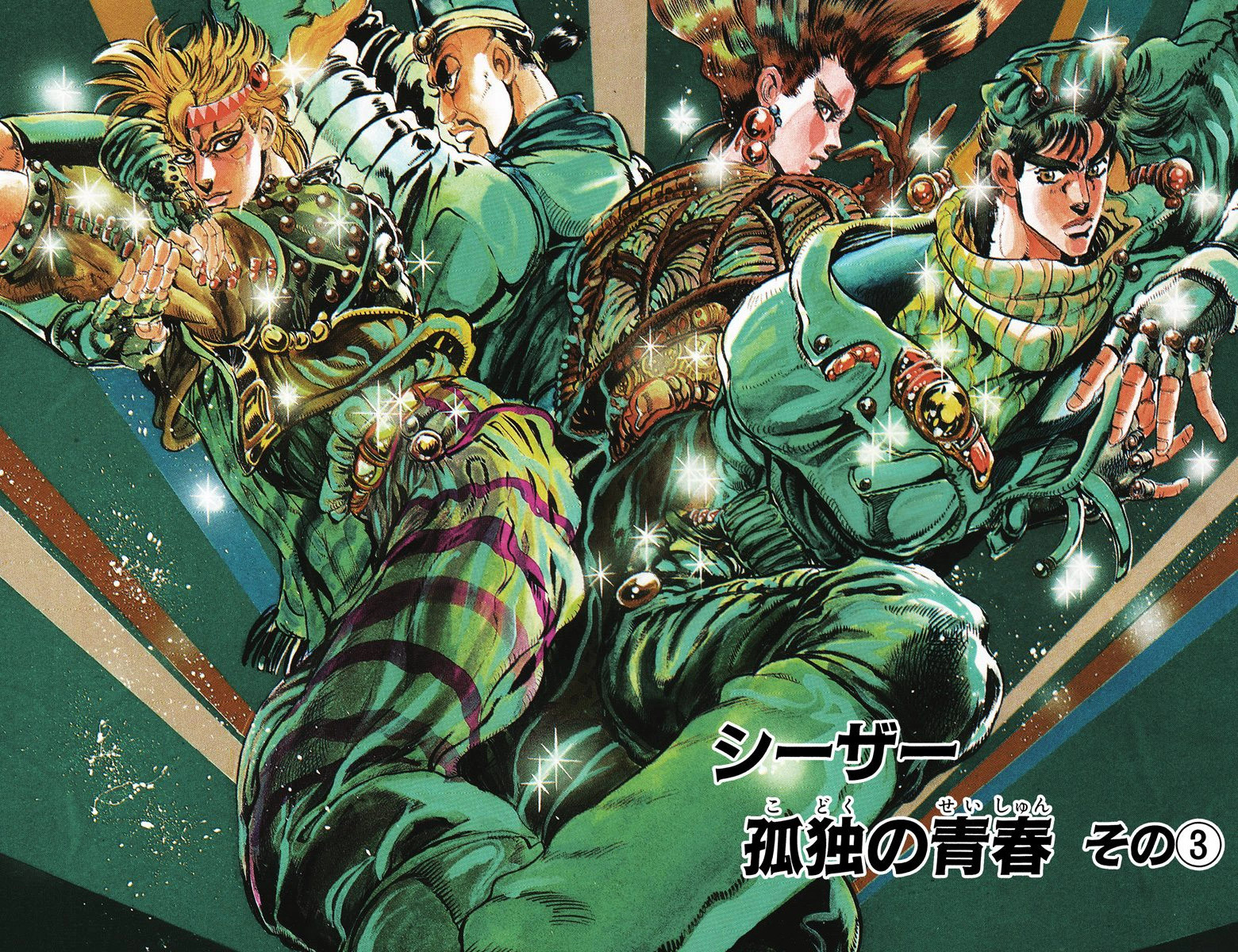
An attempt to sum it all up
Taking a step back from my JoJomania, I’d have to characterise the phenomenon as style over substance, but JoJo’s Bizarre Adventure has so much style that it sort of becomes the substance. OK, so that’s circularly glib, but it gives an idea of how I think about it.
To be serious for a minute I would say that JoJo’s Bizarre Adventure has provided me with a kind of existential solace during the Covid years - at least, thinking about JoJo at times of strife never ceases to cheer me up. Well, whether or not that makes any sense, I can definitely say JoJo’s Bizarre Adventure is a lot of silly, goofy fun, and I highly recommend it.